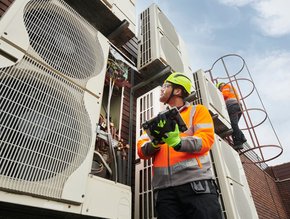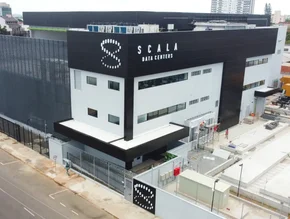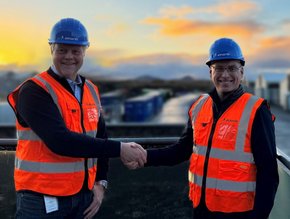Data centre growth leading the way to sustainable industry

The need for data centres continues to grow at a phenomenal pace, with research reporting that every person on Earth is creating 1.7 MB of new information every second.
This is emphasised by Distech Controls’ Senior Manager Russ Dailey and Patrick Ritchie, Key Accounts Manager Lead at Atrius, who highlight that sustainable practices will need to scale alongside data centres that are growing rapidly to meet data and storage needs.
With the data centre industry already accounting for 2% of greenhouse gas emissions, which could reach unmaintainable levels if action is now taken now, they fear.
Saying that, many data centres are already making notable strides in sustainable operations — whether hyperscalers or small and mid-sized centres — in the form of finding replicable solutions to waste heat, retrofits, energy efficiency, construction and the like
In this Q&A, both executives detail how the data centre industry — despite there being more pressure on it now than ever — is working towards curbing its environmental impact, and how best to navigate the path to a sustainable future.
What are the main actors driving the exponential growth of the data centre industry?
Cloud-based computing propels nearly every aspect of society across the globe. Commerce, travel, healthcare, education, entertainment, financial markets — they all operate on the availability of reliable data processing. The increased prevalence of artificial intelligence is also expected to further spike data centre demand. Data centres are being built at an unprecedented level; in the United States alone, the data centre market size is expected to grow from US$18.10 billion in 2023 to US$28.46bn in 2028.
How much does data centre construction and operations impact global carbon emissions?
In general, data centres have a reputation for being energy intensive. But, we must consider this represents energy expended for something that nearly every person uses every single day to function in this era. And, the data centre industry is one of the few industries that is self-regulating. It’s putting immense investment into figuring out a better way to grow in a sustainable, responsible way. We rarely hear other industries talk about sustainability like data centres do.
The data centre industry has self-interest in minimising its energy use to lower overall costs, but are there external pressures?
Considering its extent of water, energy and land use, the data centre has not had heavy governmental regulation — yet. In fact, the industry has demonstrated self-regulation because using these resources as efficiently as possible keeps them cost-efficient and agile. But government oversight is becoming a more significant factor. Regulatory agencies worldwide are proposing rapid energy waste reductions and some jurisdictions are placing moratoriums on new builds to ease energy grid strain. Other pending regulations mandate strict carbon emission reductions before the end of the decade. An imminent law in California and a proposed federal rule require large companies to publicly report their scope 3 emissions, which would include those produced by their data centre vendors on a global basis. On top of the evolving legislative landscape, industry financing is often tied to sustainability progress.
What are some replicable sustainable strategies that leading data centres are deploying?
With the vast amount of excess heat servers produce, redirecting it to warm other structures is one of the easiest methods to improve energy efficiency and even benefit the community. Amazon’s Tallaght facility in Dublin converts waste heat into power for more than 32,000sq ft of public buildings and affordable housing.
But what we are finding much more interesting is the renewed exploration of nuclear power. Small Modular Reactors (SMRs) have the potential to power data centres in a more sustainable way, because they can be built quickly, at a lower cost and have significant power capability. Standard Power is deploying up to 24 modular reactors at two of its data centres in Ohio and Pennsylvania, which will create nearly two gigawatts of power. These reactors are similar to what the US Navy uses to power submarines and aircraft carriers. Advocates also note that these SMRs don’t carry the potential for large-scale problems typically associated with nuclear energy.
Is it better in the sense of energy-efficiency to retrofit an existing centre or start fresh and build new?
It’s becoming more difficult to find acreage to build massive new structures, and the embodied carbon in a new build is also a deterrent. Retrofits have access to new funding; for example, there are grants available within the Inflation Reduction Act. Google has provided a case study of a retrofit project that turned a US$25,000 investment in airflow and cooling optimisation into a savings of US$67,000 a year and reduced PUE from 2.4 to 1.5, much closer to the ideal PUE of 1.0. Similar retrofits could improve energy efficiency and sustainable operations with a small initial investment, and without ever having downtime.
How can data centres meet demand while working toward decarbonization goals?
Decarbonisation strategies are continuing to evolve — no one knows the entire answer but many people are working on this. One resource here is the iMasons Climate Accord, a coalition working hard to find ways to improve carbon reduction accounting while building is at a record pace. It’s encouraging to see so many data centres worldwide finding creative solutions to waste heat, retrofits and energy efficiency.
The hyperscale players — Meta, Amazon, Google — have carbon reduction commitments ranging from net-zero in 2040, to carbon negative by 2030. But it’s not just the hyperscalers who can make these ambitious commitments. Iron Mountain is set to achieve it by 2040, Equinix by 2030 and Sabey Data Centers by 2029, just six years away. These are all in advance of the Paris Climate Agreement’s call to reach carbon neutrality by 2050. We see the most successful data centers developing cross-functional teams — facilities, IT, sustainability, energy management, investors — that focus on sustainability as every part of operations.
******
For more insights into the world of Data Centre - check out the latest edition of Data Centre Magazine and be sure to follow us on LinkedIn & Twitter.
Other magazines that may be of interest - Mobile Magazine.
Please also check out our upcoming event - Net Zero LIVE on 6 and 7 March 2024.
******
BizClik is a global provider of B2B digital media platforms that cover Executive Communities for CEOs, CFOs, CMOs, Sustainability leaders, Procurement & Supply Chain leaders, Technology & AI leaders, Cyber leaders, FinTech & InsurTech leaders as well as covering industries such as Manufacturing, Mining, Energy, EV, Construction, Healthcare and Food.
BizClik – based in London, Dubai, and New York – offers services such as content creation, advertising & sponsorship solutions, webinars & events.






